Tapioca Insect and Mite Pests
Tapioca Insect and Mite Pests
Spiralling Whitefly
Biology:- Egg: Eggs are tiny, elliptical, smooth surfaced, yellow to tan coloured seen usually at the under surface of the leaf in a spiralling manner and covered by waxy coating.
- Nymph: Each egg hatches into a tiny active crawler, roughly the same size as the egg. This crawler moves out over the foliage of the host plant and then transforms into, sedentary (nymph) stage and sucks nutrients from the leaves. Nymph have waxy tufts and the final larval stage (pupa) has glass like rods of wax along the sides of the body.
- Pupa: The final and fourth immature stage is considered the pupa of this species. This stage feeds during the earlier phases then stops feeding and undergoes internal tissue reorganization before molting into the adult.
- Adult: The adults are white and quite small in length and coated with a fine dust-like waxy secretion. They are most active during the morning hours.
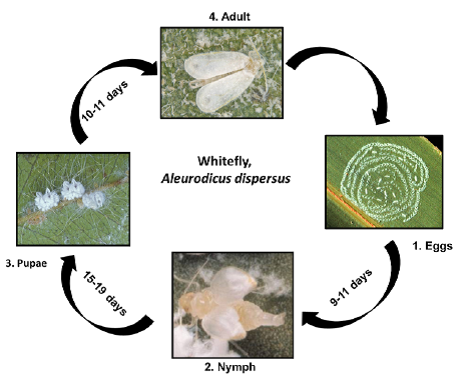
- Chlorotic spots on the leaves which latter coalesce forming irregular yellowing of leaf tissue
- Severe infestation results in premature defoliation
- Development of sooty mould
Scale insect
Biology:Found mainly on tapioca stem surfaces.
- Egg: Eggs are laid beneath the scales. The eggs hatch in 3-4 days.
- Nymph: In 20-25 days the immature stages are fully grown. The first-instar crawlers are the primary dispersal stage and walk to new areas of the plant or are dispersed by wind or animal contact. Mortality due to abiotic factors is high in this stage. There are two immature instars in the female and four in the male (including non-feeding pre-pupal and pupal stages).
- Adult: The adult produces a white waxy secretion over itself which develops into a scale. In 20- 25 days the nymphs become full grown. The male is winged and the female is wingless and sedentary. The females are wingless, firmly attached to the stems, and covered with white material. The males have wings. Method of spread: Males of the tapioca white scale can fly. However, the pest spreads mainly by wind and the transport and planting of infested stem cuttings. Reproduction is sexual. The sessile females mate with winged males, and begin to lay eggs approximately 2 days after reaching maturity
- A. albus coats the stems, side shoots and even sometimes the leaf petioles and leaf undersides.
- Infestation in the field occurs in patches around a cutting that was infested at planting.
- Heavy infestation causes desiccation of the stems, making them become thin and weak so that they often break in the wind; heath of the plant may result.
- The breakage of stems leads to profuse branching so infested plants often appear bushy.
- Tuber development in infested plants is poor, and the tuber become unpalatable

Red spider mite
Biology:- Egg: The egg is smooth, plain and elliptical. Newly laid eggs are shiny bright orange.
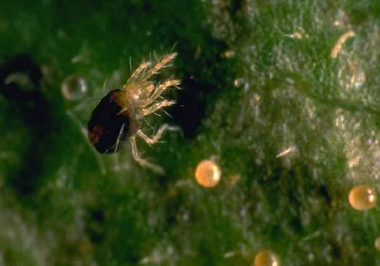 Nymph: The newly-hatched larva is bright red-orange and ovoid. It can be identified through its three pairs of short stout legs, the first two pairs positioned anteriorly. Mated females lay eggs for both sexes whereas the unmated ones produce only male eggs. Incubation period is 1-3 days. Egg hatchability is 97%.
Nymph: The newly-hatched larva is bright red-orange and ovoid. It can be identified through its three pairs of short stout legs, the first two pairs positioned anteriorly. Mated females lay eggs for both sexes whereas the unmated ones produce only male eggs. Incubation period is 1-3 days. Egg hatchability is 97%.- Adult: The adult is similar to the deutonymph but bigger and the dorsal spots are brighter. The legs and chelicerae are distinct. The preoviposition period lasts one to two days. The adult female can lay an average of 43 eggs in 20 days.
- The total developmental period (egg to adult) is about two weeks. The male to female ratio of the progenies of the mated females is 1.0:2.82. Adult males have shorter life span (18 days) than females (21 days).
- Mites suck the sap from leaves and cause leaf deformation, with
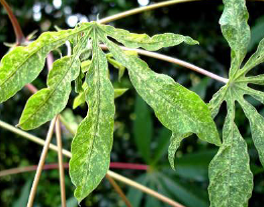
- a rough, thickened and shrivelled appearance.
- The back of the leaf may appear scorched (turn yellowish brown) and dotted with inconspicuous whitish feeding punctures.
- During heavy infestation stunting occurs.
Predators: Ladybird beetles, phytoseiid mites such as Amblysieus linearis and A. longispinosus
Mealybug
Biology:- Eggs: Females lay their eggs directly on the host in a fluted ovisac that is attached to the body of the adult female.
- Nymphs: The first instar nymphs (crawlers) are mobile. They settle on the plants, start sucking the sap and form the colonies.
- Adults: In general they have 4 female instars and 5 male instars, but unlike most other scale insects, the prepupa is quite mobile and although it may have wing buds, the legs and antennae are well developed..
Life cycle:
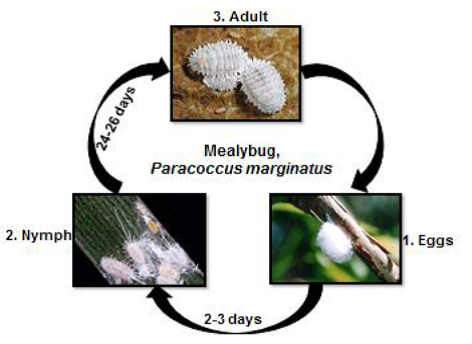
- Nymphs and adults sucks the sap from tapioca leaves, petiole and stem
- Reduction in lengths of internodes and causes the leaves to clump together into "bunchy tops".
- The pest also distorts the stems, dries up the leaves.
- Defoliation of plants at severe infestation.
- The damage is more severe in the dry than in the wet season.

Natural enemies of mealybug:
- Predators: Cryptolaemus montrouzieri, lacewings, hover flies Scymnus sp., Spalgis epius,
- Parasitoids: Anagyrus sp.,
Termites
Biology:- Egg: Eggs are dull; kidney shaped and hatches in 30-90 days.
- Nymph: Nymphs moult 8-9 times and are full grown in 6-12 months. Adult: Adult creamy coloured tiny insects resembling ants with dark coloured head.
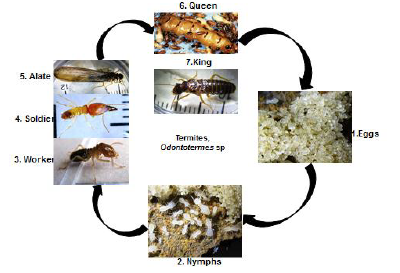
- Affected stem cuttings grow poorly, die and rot.
- This weakens the stems and causes them to break easily.
- Termite damage occurs mostly in the dry season.
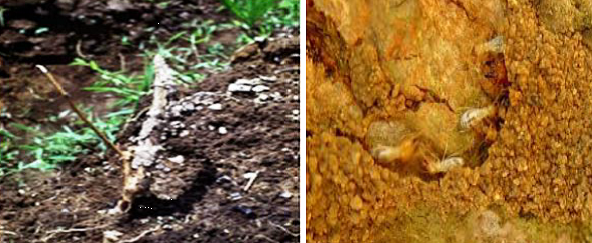
Biological control of termites through EPNs:
The infective juveniles (IJ) of EPN emerge from cadaver, search for termites, infect, kill and again multiply and remain in the moist soil.. EPN can be produced even at farmer level using either Galleria or Corcyra as a host.

IPM for Tapioca
To know the IPM practices for Tapioca, click here.
Source: NIPHM, Directorate of Plant Protection, Quarantine & Storage
Last Modified : 3/30/2020
This topic covers the information related to Insec...
This topic covers the information related to Insec...
This topic explains about Improved Cultivation Pra...
This topic covers information about Description of...
